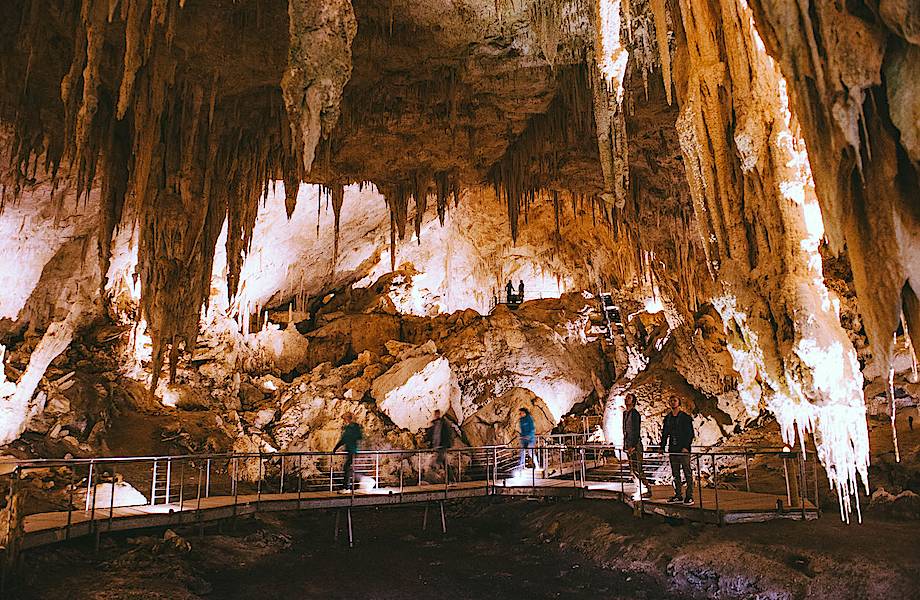White Scar Cave
White Scar Caverns is a show cave in the civil parish of Ingleton, North Yorkshire, England, below Ingleborough in the Chapel-le-Dale of the Yorkshire Dales National Park. It is a rebirth dissolution cave formed in carbonaceous limestone and is about 6 kilometers (3.7 miles) long.
It was first explored in August 1923 by two amateur geologists, Christopher Long and J.H. Churchill, but other discoveries have since been made, including The Battlefield, which is 90 meters (300 feet) long, one of the largest known cave chambers in the UK. Originally accessed via a vertical boulder, an access tunnel was cut to include it in a hiking trail.
This is an open cave, the entrance from the Ribblehead road to Ingleton in the west of Ingleborough. run all year round. Visitor amenities include a shop and cafe.
How Tom Sawyer and Becky Thatcher got lost in a cave and almost died in it, not finding a way out, is remembered by each of us who read the famous novel by Mark Twain.

It was this story that came to mind when we decided to visit the White Scar Cave – the White Scar Cave – in Yorkshire. Thank God, we did not manage to get lost, the entire route of 1 mile (1 km 600 m) was carefully fenced and lit. Visitors are interviewed for illnesses, checked for heels and provided with a tour guide with a large flashlight.
There was no reason not to believe the words written in large letters on the fence on the roof of the building, but, looking around the neighborhood with peacefully walking hens and horned goats, it was hard to believe that right here, underfoot, in the thickness of not so steep hills , hides a mysterious underground world with its beauties and its history.
And the story is, frankly, amazing. There was a diagram on the wall called Geological Clock. The stalactites that we usually see in caves grow very slowly. The very tip is marked on the diagram – this is what has grown over the “recent” time, starting from ancient Babylon, the Egyptian pyramids and the birth of Christ. The White Scar Cave began with the fact that many millions of years ago limestone rocks began to be deposited on this place. Millions, can you imagine? Not hundreds and thousands of years, but millions!
Rain, wind and other weather conditions did their job, groundwater began to erode the rock. The ubiquitous water penetrated into all sorts of cracks, gradually expanding the passages, water droplets turned into streams, and streams into rivers. And finally, we have what we have. The longest cave in the UK open to tourists.
In 1923, the cave entered the period of human development. This man was Christopher Long, who discovered a narrow gap that could only be entered by crawling. Attaching burning candles to a protective helmet on his head, day after day he squeezed further and further into the depths of the cave. A distant rumble somewhere in the bowels of the mountain served as a reference point for him. A little further on you will find out what that noise was. Not far from the entrance to the cave, visitors are shown how it was, how Christopher, sprawled in a narrow crack, crawls into the unknown. You could only look at him with a shudder!
How to take pictures in a cave
No underground expedition is complete without a photographer. A photograph taken underground is not only an illustration for a report or decoration of a tourist album, it is a document of great interest to specialists in various fields of science: geologists, hydrogeologists, crystallographers, paleontologists and others.
Photographing underground – in caves, galleries – is a very complex and interesting thing. Unusual working conditions in the caves. Shooting has to be done in the most incredible positions: fastened with a carabiner to a rope ladder, when there is a multi-meter abyss under your feet; crouched on a narrow cornice above a seething stream. You must be very careful and attentive to protect the equipment from hitting stones, from dampness and dirt. It is not uncommon for a photographer, keen on searching for a favorable shooting point, to risk getting into a very unpleasant, even dangerous situation.

This article does not pretend to be a detailed description of all the techniques and devices used for photography in caves. Here I would like to share some practical experience of working in caves, which may be of interest to an aspiring speleologist photographer.
What to take with you – going to take pictures in the cave? The minimum set seems to me like this: a camera (preferably a SLR) with the possibility of manual settings, the necessary lens, a spare battery (because it is often terribly humid in caves, batteries run out very quickly, an external flash with a set of additional batteries. All this is desirable pack – in sealed packaging.
When shooting, you often need to use a wide-angle lens. It has a large depth of field, making simple focusing easier. And because of the low light – you may have to focus manually. Another advantage of a wide-angle lens is the large coverage angle. This often decides the success of the shooting, since the dimensions of the passages and halls do not always allow you to move far enough to fit the entire object into the frame.
